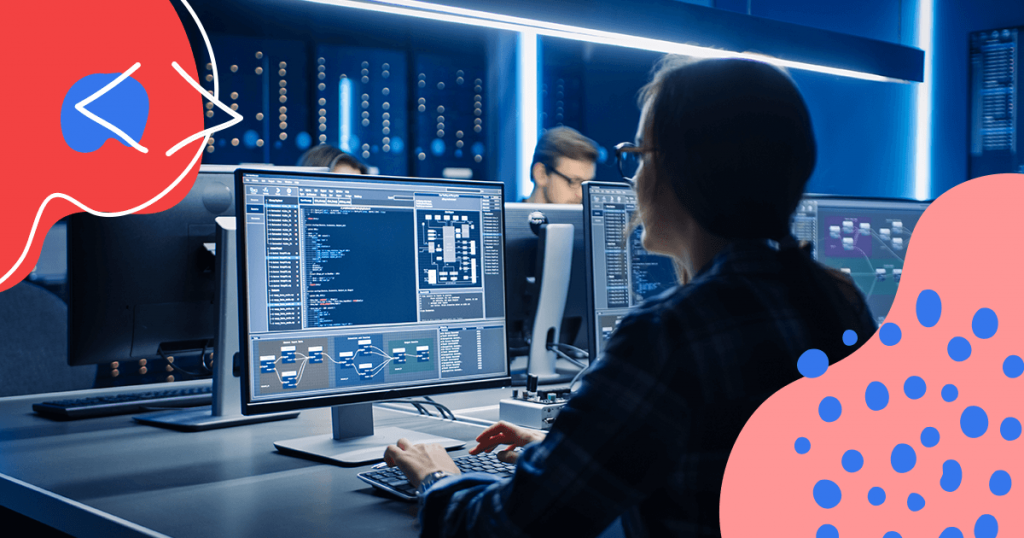Have you ever wondered how your phone knows when you leave for work or how your email inbox magically filters out spam? These are all examples of modern artificial intelligence algorithms, designed to make our lives easier.
Think about it for a moment. Almost every new piece of technology you add to your home or office incorporates some form of an AI algorithm.
And it doesn’t stop there. The same concept applies to software applications, media devices, and many other things we encounter daily. Even the traffic light you stop at on your way to work probably uses some form of artificial intelligence.
Yet, despite all the hard work these unsung computer applications do, most people don’t fully grasp their importance. In fact, the vast majority of the population doesn’t pay much attention to their existence.
To help you dive deeper into this topic, our team has put together a comprehensive guide with loads of background information and detailed examples of artificial intelligence in both marketing and everyday life.
So, here’s what you need to know about artificial intelligence algorithms, including what they are and how they work:
What Is Artificial Intelligence?
Alright, let’s get started from the beginning, okay?
Artificial intelligence is a segment of computer science that’s all about developing advanced computers and applications to mimic human intelligence.
While AI was first developed in the 1950s, its application and capabilities have grown immensely in the decades that followed.
Now, what types of artificial intelligence have led to big breakthroughs in our tech sector? Well, pretty much everything you use in your daily routine!
From the device you’re reading this on to the technology in your coffee maker, the integration of artificial intelligence into our everyday lives is abundantly clear.
However, it’s important to note that there are varying levels of artificial intelligence.
For example, machine learning enables computers to make decisions without any additional programming.
Taking it a step further, neural networks use artificial neural networks to solve complex problems.
But perhaps the coolest part about artificial intelligence is that it’s constantly changing and evolving.
As developers, engineers, and scientists continue to make strides in this crucial field, the way we integrate AI into our daily existence is bound to keep growing.
What Is an Algorithm?
Even the smallest of artificial intelligence designs need basic instructions in order to function. And that’s where algorithms come into the overall process.
Although you’ve probably heard the word in the past, you might not know what it entails.
In the simplest of terms, algorithms are step-by-step instructions that help a computer complete a calculation.
Think of it as an instruction manual that lets the machine know exactly what to do and when to do it.
Without this type of information, the computer would likely be lost on where to start or how to proceed.
Even systems with the mechanics necessary for machine learning need to have a starting place, and that’s the role an algorithm plays.
Without them, there would be no place to start the programming process.
Why do we use algorithms?
Algorithms are a huge part of today’s world.
By giving our daily tech tools the descriptive instructions they need to carry out specific tasks, we’re able to automate many of the processes human beings had to do by hand for thousands of years.
In addition, algorithms help form the intense calculation that has led to some of the greatest discoveries in medicine, science, engineering, and other areas.
Without specific formulas that offer answers to the most complicated equations known to our species, we would have never been able to improve life as we know it.
Where are algorithms used?
Did you drive a car today? Did you use a smartphone or even make a cup of coffee on a coffee maker with a digital timer? Did you check the status of your bank account or utilize a calculator?
Then you’ve encountered an algorithm at least once and most likely more.
Even access to the internet is ruled by millions of different algorithms. These special instructions used by software platforms tell your computer:
- What to show up on the screen.
- The different parts of a website to display.
- Which pages rank first on Google.
To take this idea a step further, you could technically say every bit of website coding is a form of an algorithm, as it gives computer instructions for conveying information to the masses.
How does an AI algorithm work?
Of course, as time goes on, these types of coding instructions have become even more detailed and intricate than anyone could have ever possibly imagined.
And that’s where artificial intelligence algorithms come into the picture.
Essentially, an AI algorithm is an extended subset of machine learning that tells the computer how to learn to operate on its own.
In turn, the device continues to gain knowledge to improve processes and run tasks more efficiently.
Need an example of where this is incredibly common? Think about the Alexa, Google Home, or Apple Home device you already own.
The more you interact with it, the greater it gets at being able to notice your individual preferences.
For instance, when you tell it to play your favorite song and when your spouse gives it the same command.
Artificial intelligence algorithms make it possible to tell the difference between individual voices, remember the name of a specific tune, and then play the track accordingly on your individual streaming music account.
Can I create my own AI?
Short answer? Yes.
While it was once incredibly difficult to create your own artificial intelligence algorithm, advances in technology and a high level of access to the internet are making it more simple than ever to build this type of program.
Before creating your own AI, it is important to determine your goals.
➜ If you just want a system that removes junk email and places it in your spam folder, then you’re likely just going to need a bit of computer coding to make it happen.
➜ But if you want to invent a new system of mechanics for creating a jetpack suit that you wear on your back to fight crime, then that might take more effort and a degree in mechanical engineering to achieve.
By the way, this was an Iron Man reference, and it is important to note that JARVIS is a Hollywood example of how a true AI would work.
The Role Of Artificial Intelligence Algorithms In Marketing
What if you wanted to create your own AI, but not to do your bidding or achieve world domination?
What if you just sought to make more sales, connect with your customers, and grow your business?
Now that is something that’s getting easier to do all the time!
In fact, consumers are becoming more and more focused on website experiences that adjust to their unique needs.
Whether it is a national brand that auto-adjusts its page to notice when you’re standing in one of its stores or an eCommerce brand that uses automated messaging to remind a shopper when they’ve left something behind in their cart, there are numerous ways companies are integrating this type of technology for a better overall customer experience.
And what’s really cool is that it isn’t just a factor left to mega conglomerates, either.
Even small enterprises (“mom-and-pop” businesses) are able to integrate algorithms and AI into their digital marketing strategies.
Types Of Problems Solved Using Artificial Intelligence Algorithms
There are millions of problems that have been solved using artificial intelligence algorithms, so it would be impossible to list each and every single one of them.
But it is possible to look at broader categories to see where the benefit might unfold.
A few important areas to consider are:
Healthcare
One distinct advantage of using an artificial intelligence algorithm is that it makes it easier to comb through massive amounts of data in a very short period of time. Using specialized software, medical researchers are able to get through large amounts of information to find correlations that often lead to cures, the development of lifesaving technologies, vaccine integration, and more.
Energy
The energy sector also heavily relies on artificial intelligence algorithm use. Through the increased use of computers as part of a national grid, local providers can reroute power from neighboring cities and regions to ensure that those who need it most will have electricity.
Public Safety
Another interesting use for AI algorithms is within our traffic grid. If you’ve ever wondered how a red light knows to adjust based on the flow of traffic or how some major cities can automatically change traffic based on emergency circumstances, then you’ll understand how this type of programming is utilized.
Global Warming
Those concerned about the state of our planet and global warming will be happy to know that AI is a major factor in predicting the future. Using specialized instruments and data collection tools, scientists can determine what is leading to the change in our climate and what we can do to fix it.
Communications
This is a major arena in which the use of artificial intelligence algorithms is increasingly common. From the way we access the internet to how we’re able to make a call using a smartphone, there are several problems that this level of technology has solved, making this the easiest time in history to connect to one another.
Government
Governments also use artificial intelligence algorithms on a regular basis (much to the chagrin of some people). A huge part of how the United States federal government deals with personal data is completely unknown, but monitoring certain elements and communications through computer software has led to preventing major terrorist attacks, both domestically and abroad.
And that’s just a small sampling of the ever-changing and always-expanding ways humans are using AI to broaden our horizons and make life easier, safer, and more enjoyable for future generations.
What Are The Most Known Algorithms Used In Artificial Intelligence?
Do you remember learning basic multiplication in elementary school?
It was a pretty crucial foundation of what you would end up learning in the future, which is why your teacher likely made such a big deal out of it at the time.
Artificial intelligence algorithms are a lot like this.
While there are infinite options on how to program a machine, all methods start off with a few different formulas.
In fact, there are three main category umbrellas they fall under:
Classification Algorithms
This is the type of algorithm used when you want to classify a set of data in a specific way. For example, when you mark your boss as a VIP on your email list and get a special pop-up when a fellow worker sends you a message.
Regression Algorithms
These types of algorithms are used to predict future outcomes based on a set of input data. To help you get the picture, imagine the computer programs modern meteorologists use to forecast the weather.
Clustering Algorithms
These algorithms take an entire data set and find similarities or differences between specific points. An example would be finding potentially fraudulent transactions within an accounting document or indicating who in a group of people is the same age.
➜ Question time: can you use multiple algorithms in sync to complete greater sets of calculations?
The answer is yes.
In fact, the very computer or smartphone you’re using right now can be operating with thousands of different artificial intelligence algorithms, all at once.
What has really skyrocketed in the machine learning industry is the ability to complete many different sets of instructions simultaneously.
By being able to complete multiple actions in sync, everyday devices are becoming more and more intuitive to our needs, wants, and desires.
Why Are Artificial Intelligence Algorithms So Controversial?
What would you think if we told you that there are people out there who are fully against the use of artificial intelligence algorithms?
You might not think lines of code would cause such an uproar, but it is certainly something our society faces the more we become dependent on high levels of technology.
Call it a normal level of human fear when it comes to the unknown or remnants from good (and bad) sci-fi movies, but there are quite a few who would tell you that they distrust the whole process of using artificial intelligence.
Of course, these are many of the same individuals using online banking to check account balances and order a latte from a national coffee shop chain via an app on their smartphone device.
The point?
Most people are using some form of artificial intelligence algorithms on a daily basis without even realizing it.
Yet, if you were to ask them directly if they trust this type of technology, they would say no.
A lot of the stigma surrounding the use of algorithms and AI in everyday life stems from a fear that someone might use the technology for nefarious means.
When you pick up any newspaper, you’ll find stories about hackers or other individuals causing genuine concerns. However, it’s important to remember that many of the fail-safes in place for technology protect us from these issues becoming widespread problems.
Wrap-Up: Artificial Intelligence Is Nothing New
Not only has it been around for over seventy years, it is fully integrated into nearly every facet of our lives.
While there might be a healthy distrust in the use of AI, its algorithms, and the overall growth of technology, the fact of the matter is that it is here to stay and make our lives better than ever before.
Keep in mind, though, that human creativity will forever remain essential. The key challenge lies in seamlessly integrating it with the efficiency of AI.
That’s precisely what we excel at in WriterAccess. Within our platform, you’ll discover a vibrant network of creative professionals alongside cutting-edge AI-powered tools.
Here’s a valuable tip for you: Take advantage of a 14-day free trial and witness firsthand the harmonious blend of human expertise and AI efficiency, resulting in the creation of truly captivating pieces!









